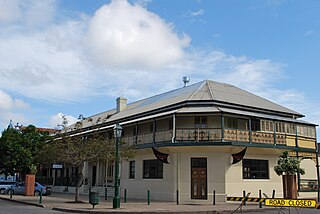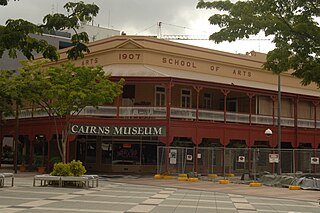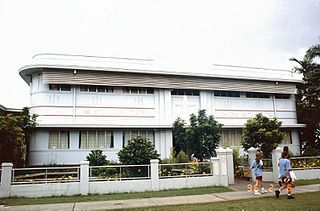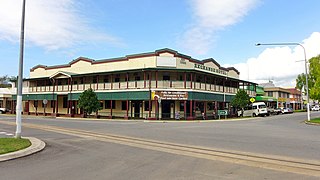
Bolands Centre is a heritage-listed department store at Lake Street, Cairns City, Cairns, Cairns Region, Queensland, Australia. Designed by Edward Gregory Waters and built in 1912, the Centre was home to a David Jones department store and a prominent toy shop. It is also known as Boland's Building and Boland's Departmental Store. It was added to the Queensland Heritage Register on 7 April 2006.

Howard Smith Wharves is a heritage-listed wharf on the Brisbane River beneath Bowen Terrace in Brisbane City and Fortitude Valley, Queensland, Australia. It was built from 1939 to 1942, and was known as Brisbane Central Wharves. The 3.5-hectare (8.6-acre) site is one of the most culturally and historically significant riverfront locations in Brisbane. It was added to the Queensland Heritage Register on 4 February 1997.

Customs House Hotel is a heritage-listed hotel at 116 Wharf Street, Maryborough, Fraser Coast Region, Queensland, Australia. It was built in 1868. It was added to the Queensland Heritage Register on 21 October 1992.

Austral Motors Building is a heritage-listed former automobile showroom at 95 Boundary Street, Fortitude Valley, City of Brisbane, Queensland, Australia. It was designed by Lange Leopold Powell and George Gerald Hutton and built from 1923 to 1925 by Blair Cunningham. It was added to the Queensland Heritage Register on 11 April 2005.

Criterion Hotel is a heritage-listed hotel at 98 Wharf Street, Maryborough, Fraser Coast Region, Queensland, Australia. It was designed by James Robertson and built from 1878 to 1883 by the Cooper Brothers. It is also known as Melbourne Hotel and Riverview Hotel. It was added to the Queensland Heritage Register on 21 October 1992.
Post Office Hotel is a heritage-listed hotel at Bazaar Street, Maryborough, Fraser Coast Region, Queensland, Australia. It was designed by Victor Emmanuel Carandini and built in 1889 by Mr Murray. It was added to the Queensland Heritage Register on 21 October 1992.

The Heritage Hotel is a heritage-listed hotel at 230 Quay Street, Rockhampton, Rockhampton Region, Queensland, Australia. It was designed by John William Wilson and built in 1898 by John Kerslake Evans. It is also known as the Old Colonial Hotel and the Commercial Hotel. It was added to the Queensland Heritage Register on 21 October 1992.

St Monica's Cathedral is the cathedral of the Catholic Church in the Diocese of Cairns. It is located at 183 Abbott Street, Cairns City, Cairns, Queensland, Australia. The cathedral was designed by Ian Ferrier and built from 1967 to 1968. It was added to the Queensland Heritage Register on 31 August 1998.

Hides Hotel is a heritage-listed hotel at 87 Lake Street, Cairns City, Cairns, Cairns Region, Queensland, Australia. It was designed by Sydenham Stanley Oxenham and built in 1928 by Michael Thomas Garvey. It is also known as Hides Cairns Hotel. It was added to the Queensland Heritage Register on 21 October 1992.

Cairns Customs House is a heritage-listed former customs house and now restaurant at 6A–8A Abbott Street, Cairns City, Cairns, Cairns Region, Queensland, Australia. It was designed by Robert Henry Bowen and built from 1936 to 1937 by Watkins & Deal. It was added to the Queensland Heritage Register on 21 October 1992.

Cairns City Council Chambers is a heritage-listed former town hall and now council library at 151 Abbott Street, Cairns City, Cairns, Cairns Region, Queensland, Australia. It was designed by Hill & Taylor and built from 1929 to 1930 by Alex McKenzie. It was added to the Queensland Heritage Register on 5 October 1998. It is now home to the Cairns City Library.

Cairns Court House Complex is a heritage-listed site incorporating a former courthouse and a former public administration building at 38–40 Abbott Street, Cairns City, Cairns, Cairns Region, Queensland, Australia. It was built from 1919 to 1921. It was added to the Queensland Heritage Register on 21 October 1992.

Central Hotel is a heritage-listed former hotel and now shopping centre at 39–49 Lake Street, Cairns City, Cairns, Cairns Region, Queensland, Australia. It was designed by Tunbridge, Tunbridge & Lynch and built from 1908 to 1909 by W Phillips. It is also known as Central Building and Central Court. It was added to the Queensland Heritage Register on 21 October 1992.

Jack and Newell Building is a heritage-listed office building at 29 Wharf Street, Cairns City, Cairns, Cairns Region, Queensland, Australia. It was built in 1911 by Hanson & Sons. It is also known as Bartlam's Ltd, Fearnley & Co. Ltd, and Nosworthy's Stores. It was added to the Queensland Heritage Register on 22 November 1996.

Cairns School of Arts is a heritage-listed former school of arts and now the Cairns Museum at 93–105 Lake Street, Cairns City, Cairns, Cairns Region, Queensland, Australia. It was designed by Tunbridge, Tunbridge & Lynch and built from 1907 to 1941 by Hanson & Sons. It was added to the Queensland Heritage Register on 21 October 1992.

St Monica's Old Cathedral is a heritage-listed former Roman Catholic cathedral at Minnie Street, Cairns City, Cairns, Cairns Region, Queensland, Australia. It was designed by Lawrence and Lordan and was built in 1927 by Michael Garvey. It is also known as St Monica's Cathedral and St Monica's Church & School. It was added to the Queensland Heritage Register on 1 July 1997.

Bishop's House is a heritage-listed former Catholic monastery and now bishop's residence at Abbott Street, Cairns City, Cairns, Cairns Region, Queensland, Australia. It was designed by Father Joseph Phelan and built in 1930 by Michael Garvey. It is also known as St Monica's Monastery/Priory. It was added to the Queensland Heritage Register on 1 July 1997.

St Monica's College Sr Cecilia Building is a heritage-listed part of the catholic school in Abbott Street, Cairns City, Cairns, Queensland, Australia. It was designed by Vibert McKirdy Brown and built in 1941 by VW Doyle. This building was once also known as St Monica's High School and was used for several years as the school administration building, although now it contains classrooms. It was added to the Queensland Heritage Register on 1 July 1997. St Monica's College is the oldest school in the Cairns region and has two heritage listed buildings - Sr Morrissey Building and the Sr Cecilia Building.

Mossman District Hospital is a heritage-listed public hospital at Johnston Road, Mossman, Shire of Douglas, Queensland, Australia. It was designed by Hill & Taylor and built c. 1930 by J J Riley. It was added to the Queensland Heritage Register on 12 June 2009.

Exchange Hotel is a heritage-listed hotel at 2 Front Street, Mossman, Shire of Douglas, Queensland, Australia. It was designed by Vibert McKirdy Brown and built from 1934 to 1935. It was also known as Daintree Inn. It was added to the Queensland Heritage Register on 9 November 2012.





















